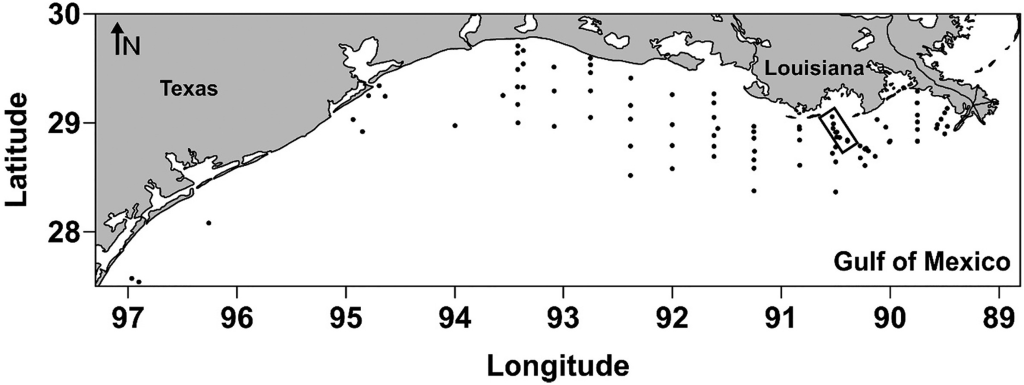NCCOS sponsored researchers analyzed common phytoplankton taxa and accompanying environmental data for 672 surface water samples collected from 95 stations located on the Louisiana/Texas shelf (Gulf of Mexico) between 1990 and 2011. This comprehensive study found distinct phytoplankton species assemblages and identified seasonal trends. The study demonstrates the importance of physical processes and seasonality in determining phytoplankton communities and highlights the importance of taxonomy.

Highlights of the study are:
-
-
- Temperature, stratification, and depth are most related to phytoplankton composition variability.
- Dissolved nutrient concentrations appear to drive overall phytoplankton biomass.
- Phytoplankton on the Louisiana shelf can be distinguished into spring bloom, summer and winter assemblages.
-
Nutrient inputs from the Mississippi River drive northern Gulf of Mexico primary production, which in turn supports very productive fisheries (e.g., Gulf menhaden and shrimp). This high phytoplankton productivity has had negative consequences, however, including chronic hypoxia of bottom waters on the shelf and frequent harmful algal blooms, particularly of the diatom Pseudo-nitzschia which can produce the neurotoxin domoic acid. Additionally, the high nitrate inputs of the Mississippi River can lead to secondary nutrient limitation, particularly silica for diatoms, which causes a trophic cascade in the reduction in diatom biomass and a subsequent reduction in copepod zooplankton biomass (consumers of diatoms).
Phytoplankton were identified to the lowest practical taxonomic unit from preserved samples. Twenty-six phytoplankton taxa (primarily diatoms) that were > 8 microns in size were identified to genus-level and ranked in at least one of three separate categories (average abundance; frequency of occurrence; and bloom frequency).
Nineteen of the 26 taxa were diatoms, four were dinoflagellates, two were cyanobacteria, and one was a ciliate. As the Mississippi River water mass mixes with the northern Gulf of Mexico coastal (and/or oceanic) water mass, the resultant phytoplankton assemblage is a mix of marine and freshwater forms.
Of the five environmental variables (temperature, salinity, secchi disk depth, stratification, and inorganic nutrients) evaluated in the study, temperature, stratification, and secchi depth constituted the combination best statistically related to the phytoplankton community composition patterns across the 672 samples. The optimal environmental parameters associated with the 26 phytoplankton taxa were calculated and plotted (Fig. 1), and the taxa were grouped into common phytoplankton clusters (i.e., niches).
The phytoplankton clustered into three seasonal assemblages. Group A is composed of taxa with optima typical of summer months: higher temperatures typical of June and July, highly stratified waters and higher ammonium concentrations that would be expected of post-spring bloom conditions (i.e., summer) when recycled nitrogen would be more abundant. Group B is characterized as a winter group, with lower optima for temperature typical of December and January, lower reactive nitrogen species (NOx) and ammonium (i.e., lower river inputs in winter) and higher optima for salinity and Si:N (reflecting generally lower river flow and nitrogen inputs). Group C (spring) appears to be a higher flow (and/or nearshore) group with evidence of higher nitrate levels and higher Si:P ratio and SiO3 (expected with higher freshwater inputs).
This long-term study provides a base-line reference to examine phytoplankton responses to future environmental perturbations.
This study was supported in part by project funding from the NCCOS NGOMEX and NECOP programs. NCCOS’ Dr. Quay Dortch played an instrumental role in the collection and analysis of much of the data utilized in this study.
Citation: Parsons, Michael L., Ashley L. Brandt, R. Eugene Turner, Wendy L. Morrison and Nancy N. Ralabais. 2021. Characterization of common phytoplankton on the Louisiana shelf. Marine Pollution Bulletin 168, 112458. https://doi.org/10.1016/j.marpolbul.2021.112458

